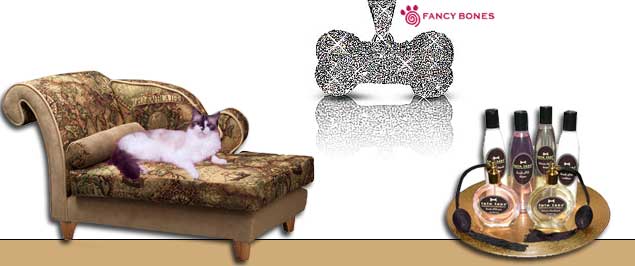 |
|
After spending years with your cat, you may think you know everything there is to know about her. But here are 10 things that your favorite feline
may not have gotten around to sharing with you.
1. A domestic cat can run about 31 mph. Running fast is something usually attributed to wild cats, gazelles and greyhounds, but your house kitty is pretty
speedy.
2. It is possible for every kitten in a litter to have a different father. Hopefully, she is spayed so there's no risk of an unexpected pregnancy.
3. Cats walk on their toes, which probably accounts
for their graceful movements. In ballet there is a step called pas de chat -- the cat step. It's a little jump to the side, but in truth
nearly every move your cat makes is lovely.
4. A cat's collarbone isn't connected to his other bones; it's buried
in the muscles, which is how kitty can fit through small places. He's not boneless -- even though it looks that way sometimes
-- but he is adaptable. A cat actually has more bones than a human.
5. Your cat will respond only to catnip (an herb in the mint family) if she has the catnip gene. Not every cat is born with this gene, and it doesn't
show up right away, so don't expect a young kitty to respond to catnip the way an older one will.
6. Thirty-two
muscles control a cat's outer ear, and he can rotate it 10 times faster than a dog. In fact, kitty can rotate each ear 180
degrees.
7. Cats have scent glands in their cheeks, so if your cat rubs against you she is "marking"
you as hers. She really does love you. She'll also mark furniture and clothing this way. Everything she likes is hers. It's
also her way of leaving her "mark" to say that she was there.
8. Cats can move their jaws only up and
down; they can't move them side to side like a dog or human.
9. Cats whiskers are extremely sensitive. They not
only help the cat locate where she is in the dark, but how the cat moves them is an indicator of the cat's feelings at any
given time. The top two rows of whiskers can move independently of the bottom two rows.
10. Cats are obligate carnivores.
This means they must eat meat. So even if you're a vegetarian, you need to come to grips with the fact that your cat can't be. He will get very sick and die without meat
in his diet.
As you probably already know, spending time learning more about your cat is time well spent. In fact,
these cat facts are just the tip of the iceberg. Your cat has much more to tell you if you pay attention, watch and learn. As the late Ernest Hemingway said, "A cat has absolute emotional honesty: human beings, for one reason or another, may hide their
feelings, but a cat does not."
|
 Cat and
Dog Gas: 8 Things You Never Wanted to KnowBy Amanda Baltazar Sure
it's funny at first -- but if you've got a flatulent pet, your nose will quickly tell you it's no laughing matter.Fortunately,
you don't have to resort to wearing a mask, and trust us, your pet doesn't mind basking in his own stench. While
some dog breeds such as Boxers, Bulldogs, Pugs, Pekinese and deep-chested dogs like hounds are more prone to gas than others, there are steps you can
take to reduce or prevent gas:1. One Day at a TimeWhether it's a new whole food or a new or brand of pet food,
introduce different products very slowly -- little-by-little over the course of at least two weeks.2.
Fiber and FatCutting
the fat in your pet's diet and replacing it with fiber will relieve flatulent symtoms 95% of the time, says Dean Severidt,
DVM, a veterinarian of 30 years. 3. Sloooow DownEating too quickly is a major cause of gas in pets because the dog or cat
consumes a lot of air.Add a little water to dry food, which forces your cat or dog to eat more slowly,
says Stacy Alldredge, owner of Who's Walking Who, a dog training school in New York.You can also buy a special
dog bowl that's designed to slow down gulpers, or put the food in a variety of food-hiding balls. The latter are designed
to keep a dog busy so she eat more slowly. And, says Alldredge, if you hide them around the house it can take even longer
to eat.4. Vengeance from Vegetables Steer clear of foods known to cause gas. Asparagus, cabbage, cauliflower, broccoli, beans
and nuts are big offenders. Soy is also problematic, says holistic veterinarian Jean Hofve, DVM, because dogs lack the enzymes
needed to digest soy. Soy is mostly added to lower-end foods. 5. SupplementsDr. Ernie Ward, a small animal practitioner
for 20 years, recommends adding yucca schidigera to your pet's food to reduce flatulence. This can be purchased in health
food stores but many foods already contain it, he says. Or pick treats that contain charcoal, which helps with gas. As a last
resort, he suggests Simethicone, which is in many antacids, typically non-prescription. Check with your vet first, of course.
Hofve
advises adding digestive enzymes or probiotics to your pet's food.6. StimulationMake sure your pet is stimulated throughout the day, says Hofve. "If
food is the only thing they have to look forward to, pets are bored and will eat too quickly."7.
Quality over QuantityGeorge
Luntz, president and co-founder of the natural pet remedies site PetAlive.com, advises giving your pet the best quality food you can, preferably organic, because it has fewer
fillers in it. But try to spread the food over two meals rather than one, he says.8. After The
FactIt's too late: You've got
a gassy pet. A little light exercise should help work it out and could stimulate a bowel movement, says Luntz, but don't do
anything too vigorous immediately after a meal.Cat Scratching
- 7 great tips on how to save your furnitureby Amy D. Shojai Amy
Shojai is a certified animal behavior consultant and the award-winning author
of 23 pet care books,
Understanding
Why They Scratch and Claw
Kittens and adult cats claw for many reasons. Clawing feels good and provides
a great shoulder and leg workout. Clawing keeps feline nails healthy by cleaning off old layers. Clawing marks kitty territory
with visual cues (including your shredded upholstery) and paw pad scent.
Your cat's clawing behavior may raise
your blood pressure, but it relieves feline stress, sort of like the kitty equivalent to human nail biting. In fact,
upset cats often target items that smell like their beloved human (your bed, your favorite chair), not because they're angry
or vindictive, but because they love you so much and scent-sharing makes them feel better. Once you understand their motivations,
you'll be able to better train them toward less-destructive clawing.
Using Kitten Aptitude Training
These seven tips and strategies can help you redirect your cat's clawing behaviors:
1. Offer Cat Scratching
Options That Suit Your Pet: Irresistible choices match the cat's desires for texture and style. Does your cat scratch
horizontally or vertically -- or maybe overhead while scooting on her back? Does he target upholstery, carpet, soft fabric
or hardwood? Choose cat scratchers accordingly. Scratch objects should be taller or longer than the cat's full-length
stretch as an adult (because kittens do grow!) and sturdy enough it won't tip over under a full-out scratch assault.
2. Learn the Best Locations for the
Scratchers: Clawing is territorial marking
ruled by location. Cats want the whole world to see their scratch-graffiti, so don't hide the post away in a back room. Take
a cue from the location of the shredded sofa or carpet on the stairs. Important pathways, lookouts (near windows), feeding
stations and potty locations all fit the feline real estate criteria.
3. Use the 1+1 Rule for Cat Furniture:
Provide a scratch object for every cat in the house, plus one. That means two cats should have at least three legal places
to scratch. Some cats won't want to share and having posts in multiple locations means even a singleton cat has no excuse
to use the bedroom mattress instead.
4. Actively Entice Your Cat: Use a feather toy or other irresistible
lure to draw the kitten's attention to the right target. Tempt the kitten to climb and claw, and praise with soft, happy encouragement.
Older kittens and adults that react to catnip may be attracted to a catnip-spiked claw object. A tattered, scratched-up post
looks good to a cat, so don't replace it. And catch kitty in the act of doing it right, and praise, praise, praise!
5. Focus Training Efforts: Make the "legal" scratch object irresistible while making furniture
unattractive -- at least until the kitty accepts the proper post.
- Place the legal scratch object right in front
of the scratched sofa. You know the cat already likes the location, so keep the scratcher there until the cat changes scratch-allegiance
to the legal target.
- Make your sofa less appealing for your cat's claws. Consider using double-sided tape on
prime scratching spots, as it feels nasty to paws. Another option, depending on the color of your furniture, is to dust baby
powder or cinnamon on the furniture for a scented and poof-in-the-face reminder if claws hit.
- Interrupt wrong
behaviors with a hand-clap or short hissing sound, and then redirect to the right object and praise.
6.
Time Training Carefully: Cats love routine and often scratch at the same times and places each day: after naps, after
meals, as a greeting display (when you come home), after play. Schedule claw-training during these times.
7.
Keep Claws Trimmed: Needle-sharp kitten claws are easy to clip with human nail clippers. Try clipping one claw each
night when Junior sleeps on your lap. Gently press the pad to express the claw, and clip just the sharp end, avoiding the
pink. Dull claws do less damage even if Junior forgets and scratches in the wrong place. Kittens that accept claw trims grow
into adults that accept paw handling, too. Vinyl nail covers (in fashion colors) also are an option. These glue onto the cat's
claws to prevent clawing damage but grow out and must be replaced regularly.
Remember, every kitten is different.
Some rarely scratch at all, while others become scratch-aholics, especially during emotional upset. Kitten Aptitude Training
offers basic help to positively manage your kitten's claws-and-effect
How Old Is Your Cat? A popular
misconception is that cats age seven years for each calendar year. But in reality, feline aging is much more rapid during the first two years of life. A cat reaches the approximate human age of 15 during its first year, then 24 at age two. Each year thereafter, it
ages approximately four "cat years" for every calendar year. |
| |
|
|
|
